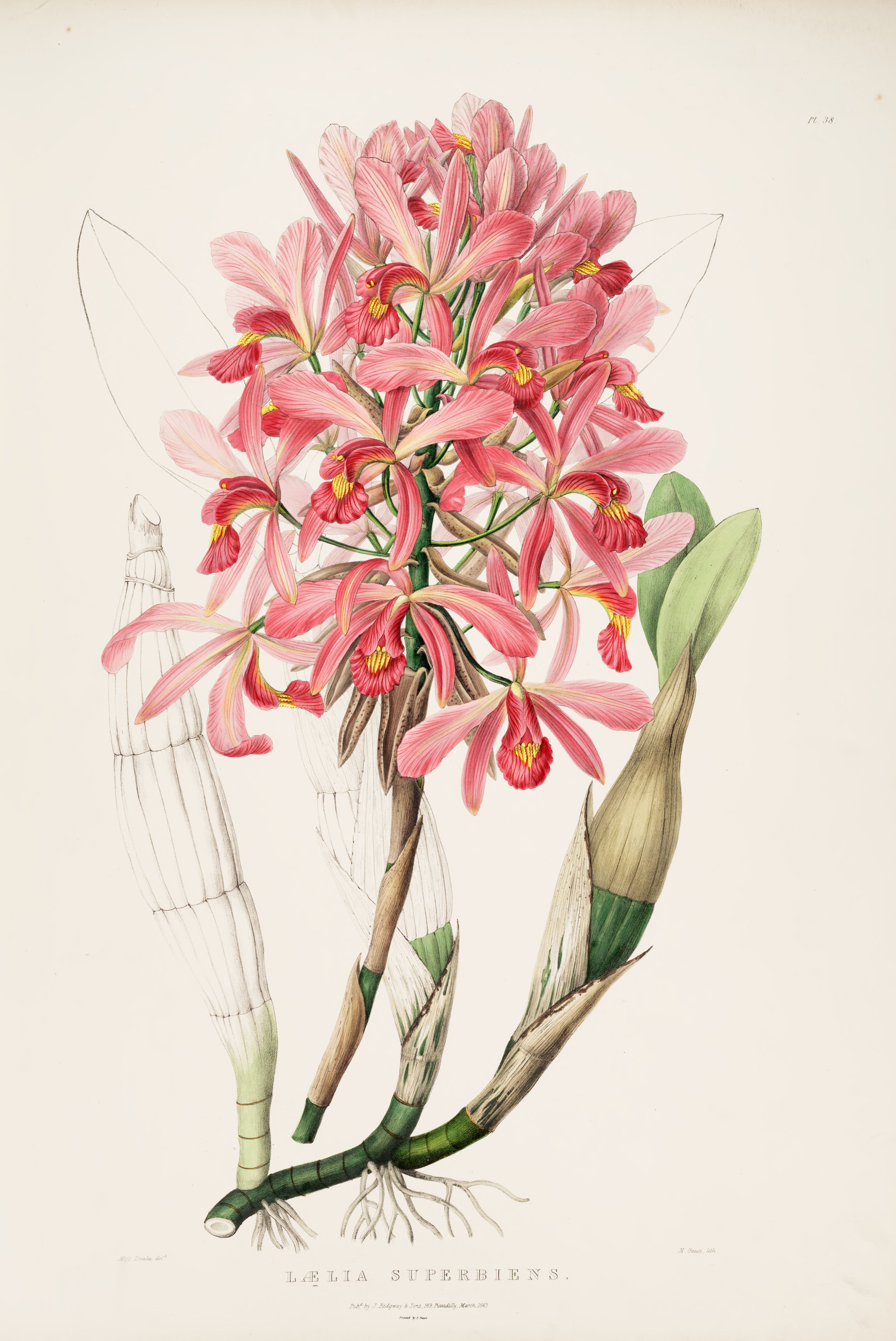|
Epidendrum Compressum
''Epidendrum compressum'' ("compressed upon a tree") is a species of orchid in the genus ''Epidendrum'' from wet montane forests of Trinidad, Venezuela, Colombia, Ecuador, Peru and Bolivia. Nomenclatural history Eduard Friedrich Poeppig & Stephan Endlicher published the first description of this orchid in 1836, and called it ''Epidendrum laxum''. However, because this name had already been used by Olof Swartz in 1788 to describe a very different orchid, now known as ''Pleurothallis laxa'', ''Epidendrum laxum'' Poepp. & Endl. (1836) became an Illegitimate name. It was under this illegitimate name that Reichenbach, in 1861, classified ''E. compressum'' into his section ''Polycladia'' of Lindley's subgenus ''Amphiglotium'' of the genus ''Epidendrum''. In 1864, August Grisebach published a description of the species ''Epidendrum compressum'', the binomial now accepted by Kew. Description According to Poeppig, ''E. compressum'' grows epiphytically in Peruvian fore ... [...More Info...] [...Related Items...] OR: [Wikipedia] [Google] [Baidu] |
Epiphyte
An epiphyte is an organism that grows on the surface of a plant and derives its moisture and nutrients from the air, rain, water (in marine environments) or from debris accumulating around it. The plants on which epiphytes grow are called phorophytes. Epiphytes take part in nutrient cycles and add to both the diversity and biomass of the ecosystem in which they occur, like any other organism. They are an important source of food for many species. Typically, the older parts of a plant will have more epiphytes growing on them. Epiphytes differ from parasites in that they grow on other plants for physical support and do not necessarily affect the host negatively. An organism that grows on another organism that is not a plant may be called an epibiont. Epiphytes are usually found in the temperate zone (e.g., many mosses, liverworts, lichens, and algae) or in the tropics (e.g., many ferns, cacti, orchids, and bromeliads). Epiphyte species make good houseplants due to their minimal wat ... [...More Info...] [...Related Items...] OR: [Wikipedia] [Google] [Baidu] |
Orchids Of Venezuela
Orchids are plants that belong to the family Orchidaceae (), a diverse and widespread group of flowering plants with blooms that are often colourful and fragrant. Along with the Asteraceae, they are one of the two largest families of flowering plants. The Orchidaceae have about 28,000 currently accepted species, distributed in about 763 genera. (See ''External links'' below). The determination of which family is larger is still under debate, because verified data on the members of such enormous families are continually in flux. Regardless, the number of orchid species is nearly equal to the number of bony fishes, more than twice the number of bird species, and about four times the number of mammal species. The family encompasses about 6–11% of all species of seed plants. The largest genera are ''Bulbophyllum'' (2,000 species), ''Epidendrum'' (1,500 species), ''Dendrobium'' (1,400 species) and ''Pleurothallis'' (1,000 species). It also includes ''Vanilla'' (the genus of the ... [...More Info...] [...Related Items...] OR: [Wikipedia] [Google] [Baidu] |
Orchids Of Peru
Orchids are plants that belong to the family Orchidaceae (), a diverse and widespread group of flowering plants with blooms that are often colourful and fragrant. Along with the Asteraceae, they are one of the two largest families of flowering plants. The Orchidaceae have about 28,000 currently accepted species, distributed in about 763 genera. (See ''External links'' below). The determination of which family is larger is still under debate, because verified data on the members of such enormous families are continually in flux. Regardless, the number of orchid species is nearly equal to the number of bony fishes, more than twice the number of bird species, and about four times the number of mammal species. The family encompasses about 6–11% of all species of seed plants. The largest genera are ''Bulbophyllum'' (2,000 species), ''Epidendrum'' (1,500 species), ''Dendrobium'' (1,400 species) and ''Pleurothallis'' (1,000 species). It also includes ''Vanilla'' (the genus of the ... [...More Info...] [...Related Items...] OR: [Wikipedia] [Google] [Baidu] |
Orchids Of Ecuador
Orchids are plants that belong to the family Orchidaceae (), a diverse and widespread group of flowering plants with blooms that are often colourful and fragrant. Along with the Asteraceae, they are one of the two largest families of flowering plants. The Orchidaceae have about 28,000 currently accepted species, distributed in about 763 genera. (See ''External links'' below). The determination of which family is larger is still under debate, because verified data on the members of such enormous families are continually in flux. Regardless, the number of orchid species is nearly equal to the number of bony fishes, more than twice the number of bird species, and about four times the number of mammal species. The family encompasses about 6–11% of all species of seed plants. The largest genera are ''Bulbophyllum'' (2,000 species), ''Epidendrum'' (1,500 species), ''Dendrobium'' (1,400 species) and ''Pleurothallis'' (1,000 species). It also includes ''Vanilla'' (the genus of the ... [...More Info...] [...Related Items...] OR: [Wikipedia] [Google] [Baidu] |
Orchids Of Colombia
Orchids are plants that belong to the family Orchidaceae (), a diverse and widespread group of flowering plants with blooms that are often colourful and fragrant. Along with the Asteraceae, they are one of the two largest families of flowering plants. The Orchidaceae have about 28,000 currently accepted species, distributed in about 763 genera. (See ''External links'' below). The determination of which family is larger is still under debate, because verified data on the members of such enormous families are continually in flux. Regardless, the number of orchid species is nearly equal to the number of bony fishes, more than twice the number of bird species, and about four times the number of mammal species. The family encompasses about 6–11% of all species of seed plants. The largest genera are '' Bulbophyllum'' (2,000 species), '' Epidendrum'' (1,500 species), '' Dendrobium'' (1,400 species) and '' Pleurothallis'' (1,000 species). It also includes ''Vanilla'' (the genus of t ... [...More Info...] [...Related Items...] OR: [Wikipedia] [Google] [Baidu] |
Orchids Of Bolivia
Orchids are plants that belong to the family Orchidaceae (), a diverse and widespread group of flowering plants with blooms that are often colourful and fragrant. Along with the Asteraceae, they are one of the two largest families of flowering plants. The Orchidaceae have about 28,000 currently accepted species, distributed in about 763 genera. (See ''External links'' below). The determination of which family is larger is still under debate, because verified data on the members of such enormous families are continually in flux. Regardless, the number of orchid species is nearly equal to the number of bony fishes, more than twice the number of bird species, and about four times the number of mammal species. The family encompasses about 6–11% of all species of seed plants. The largest genera are ''Bulbophyllum'' (2,000 species), ''Epidendrum'' (1,500 species), ''Dendrobium'' (1,400 species) and ''Pleurothallis'' (1,000 species). It also includes ''Vanilla'' (the genus of the ... [...More Info...] [...Related Items...] OR: [Wikipedia] [Google] [Baidu] |
Epidendrum Sect
''Epidendrum'' , abbreviated Epi in the horticultural trade, is a large neotropical genus of the orchid family. With more than 1,500 species, some authors describe it as a mega-genus. The genus name (from Greek ''επί, epi'' and ''δένδρον, dendron'', "upon trees") refers to its epiphytic growth habit. When Carl Linnaeus named this genus in 1763, he included in this genus all the epiphytic orchids known to him. Although few of these orchids are still included in the genus ''Epidendrum'', some species of ''Epidendrum'' are nevertheless not epiphytic. Distribution and ecology They are native to the tropics and subtropical regions of the American continents, from North Carolina to Argentina. Their habitat can be epiphytic, terrestrial (such as '' E. fulgens''), or even lithophytic (growing on bare rock, such as '' E. calanthum'' and '' E. saxatile''). Many are grown in the Andes, at altitudes between 1,000 and 3,000 m. Their habitats include humid jungles, d ... [...More Info...] [...Related Items...] OR: [Wikipedia] [Google] [Baidu] |
Labellum (botany)
In botany, the labellum (or lip) is the part of the flower of an orchid or '' Canna'', or other less-known genera, that serves to attract insects, which pollinate the flower, and acts as a landing platform for them. ''Labellum'' (plural: ''labella'') is the Latin diminutive of ''labrum'', meaning lip. The labellum is a modified petal and can be distinguished from the other petals and from the sepals by its large size and its often irregular shape. It is not unusual for the other two petals of an orchid flower to look like the sepals, so that the labellum stands out as distinct. Bailey, L. H. ''Gentes Herbarum: Canna x orchiodes''. (Ithaca), 1 (3): 120 (1923); Khoshoo, T. N. & Guha, I. ''Origin and Evolution of Cultivated Cannas.'' Vikas Publishing House. In orchids, the labellum is the modified median petal that sits opposite from the fertile anther and usually highly modified from the other perianth segments. It is often united with the column and can be hinged or movable, fac ... [...More Info...] [...Related Items...] OR: [Wikipedia] [Google] [Baidu] |
Perianth
The perianth (perigonium, perigon or perigone in monocots) is the non-reproductive part of the flower, and structure that forms an envelope surrounding the sexual organs, consisting of the calyx (sepals) and the corolla (petals) or tepals when called a perigone. The term ''perianth'' is derived from Greek περί (, "around") and άνθος (, "flower"), while ''perigonium'' is derived from περί () and γόνος (, "seed, sex organs"). In the mosses and liverworts (Marchantiophyta), the perianth is the sterile tubelike tissue that surrounds the female reproductive structure (or developing sporophyte). Flowering plants In flowering plants, the perianth may be described as being either dichlamydeous/heterochlamydeous in which the calyx and corolla are clearly separate, or homochlamydeous, in which they are indistinguishable (and the sepals and petals are collectively referred to as tepals). When the perianth is in two whorls, it is described as biseriate. While the c ... [...More Info...] [...Related Items...] OR: [Wikipedia] [Google] [Baidu] |
Pasco Region
Pasco () is a department and region in central Peru. Its capital is Cerro de Pasco. Political division The region is divided into 3 provinces ( es, provincias, singular: ), which are composed of 28 districts (''distritos'', singular: ''distrito''). Provinces The provinces, with their capitals in parentheses, are: * Daniel Alcídes Carrión (Yanahuanca) * Oxapampa (Oxapampa) * Pasco (Cerro de Pasco) Places of interest * Cerro de la Sal * El Sira Communal Reserve * Gran Pajonal * San Matías–San Carlos Protection Forest * Yanachaga–Chemillén National Park * Yanesha Communal Reserve The Communal Reservation Yanesha or Yanesha Community Reserve is a communal reserve in the Palcazu District of Oxapampa Province of Peru. It covers an area of in the Palcazu River basin. The reserve was creating by law on April 28, 1988, to prot ... External links Gobierno Regional Pasco – Pasco Regional Government official website Regions of Peru {{Pasco-geo-stub ... [...More Info...] [...Related Items...] OR: [Wikipedia] [Google] [Baidu] |
Sympodial
Sympodial growth is a bifurcating branching pattern where one branch develops more strongly than the other, resulting in the stronger branches forming the primary shoot and the weaker branches appearing laterally. A sympodium, also referred to as a sympode or pseudaxis, is the primary shoot, comprising the stronger branches, formed during sympodial growth. The pattern is similar to dichotomous branching; it is characterized by branching along stems or hyphae. In botany, sympodial growth occurs when the apical meristem is terminated and growth is continued by one or more lateral meristems, which repeat the process. The apical meristem may be consumed to make an inflorescence or other determinate structure, or it may be aborted. Types If the sympodium is always formed on the same side of the branch bifurcation, e.g. always on the right side, the branching structure is called a helicoid cyme or bostryx. If the sympodium occurs alternately, e.g. on the right and then the left, ... [...More Info...] [...Related Items...] OR: [Wikipedia] [Google] [Baidu] |




.jpg)


